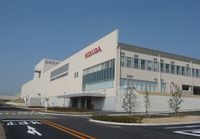"The Factory at the foot of Mount Aso, where humans and nature are as one." That's how Honda literature describes the Kumamoto factory, the largest motorcycle manufacturing facility in the world.
By any measure, Kumamoto is impressive. Covering almost 1.7-million square meters, the Kumamoto plant blankets as much area as 36 baseball stadiums. It employs 3,300 "associates," who work together to build 87 motorcycle models and 53 different engines. More than 1,800 motorcycle and scooters roll off Kumamoto's assembly lines each day—that's one every 90 seconds. It's the most prolific motorcycle production facility by a factor of many, but to hear the General Manager, Watanabe-san, describe it, you might think that clean water and fresh air—not motorcycles—are the most important end product.
Kumamoto’s mechanical facilities are impressive enough. Every element of motorcycle manufacturing, from die-casting aluminum engine cases to painting to final assembly, is handled on-site. More impressive, however, are the extensive environmental controls built into this amazing facility. Harkening back to company founder Soichiro Honda’s belief that Honda should never “build boundaries between ourselves and the local environment,” Watanabe explained in detail how the Kumamoto facility has been outfitted to protect the local Mount Aso environment.
An on-site, closed-loop wastewater treatment plant, big enough to serve a small city, treats and reuses all of the plant’s waste water without dumping any off-site. A high-tech rainwater usage facility contributes to freshwater demands. Renewable electricity from wind turbines on the slopes of nearby Mount Aso provide power to the plant, supplemented by 1,008 individual solar panels (manufactured by Honda Soltec) mounted to the roof of the Kumamoto building. The air conditioning is eco-friendly as well, recirculating cool air that has been captured from cavities deep underground. Even the area surrounding the Kumamoto facility is eco-correct, having been recently replanted with native forest species to create a green belt to supports indigenous wildlife.
It’s interesting to see a manufacturing concern as dedicated to greening its facilities as it is in greening up its end-products. Especially in the realm of recreational motorcycling—criticized by some as a frivolous and conspicuous consumption of natural resources (moto-communters obviously excepted)—it’s good to know that Honda is making a real and meaningful contributions to improving the well-being of the world we ride in.











/cloudfront-us-east-1.images.arcpublishing.com/octane/2WF3SCE3NFBQXLDNJM7KMXA45E.jpg)
/cloudfront-us-east-1.images.arcpublishing.com/octane/G4MG6OUCJNBSHIS2MVVOTPX65E.jpg)
/cloudfront-us-east-1.images.arcpublishing.com/octane/IIGGWFOTOJGB7DB6DGBXCCMTDY.jpg)
/cloudfront-us-east-1.images.arcpublishing.com/octane/QSTCM6AVEZA5JJBUXNIQ3DSOF4.jpg)
/cloudfront-us-east-1.images.arcpublishing.com/octane/U4I7G625B5DMLF2DVIJDFZVV6M.jpg)
/cloudfront-us-east-1.images.arcpublishing.com/octane/B6XD6LS6IVCQPIU6HXDJSM3FHY.jpg)
/cloudfront-us-east-1.images.arcpublishing.com/octane/ICL63FEDDRDTTMINYICCEYGMDA.jpg)
/cloudfront-us-east-1.images.arcpublishing.com/octane/FCGZHQXRBZFLBAPC5SDIQLVF4I.jpg)
/cloudfront-us-east-1.images.arcpublishing.com/octane/WNOB6LDOIFFHJKPSVIWDYUGOPM.jpg)

/cloudfront-us-east-1.images.arcpublishing.com/octane/X33NU3E525ECRHXLNUJN2FTRKI.jpg)
/cloudfront-us-east-1.images.arcpublishing.com/octane/6KKT5NNL2JAVBOXMZYS5ZO76YA.jpg)
/cloudfront-us-east-1.images.arcpublishing.com/octane/J5RKG5O455GMPGQRF2OG6LRT7A.jpg)
/cloudfront-us-east-1.images.arcpublishing.com/octane/GX2CIZKQVRH2TATDM26KFG2DAE.jpg)
/cloudfront-us-east-1.images.arcpublishing.com/octane/ZWIDYSAKQZHD5BHREMQILXJCGM.jpg)
/cloudfront-us-east-1.images.arcpublishing.com/octane/CYUHJZCTSJCH3MRAQEIKXK7SCQ.jpg)
/cloudfront-us-east-1.images.arcpublishing.com/octane/LKOFINY56FCXJCANJ5M7ZDQUBY.jpg)
/cloudfront-us-east-1.images.arcpublishing.com/octane/4NBPDACMWJH63JQYJVK3QRBDZI.jpg)
/cloudfront-us-east-1.images.arcpublishing.com/octane/KKHQHRR3FJGX7H2IPU6RALMWG4.jpg)

/cloudfront-us-east-1.images.arcpublishing.com/octane/5IOFS5JAE5FOXMNA23ZRAVVYUU.jpg)
/cloudfront-us-east-1.images.arcpublishing.com/octane/CGXQ3O2VVJF7PGTYR3QICTLDLM.jpg)

/cloudfront-us-east-1.images.arcpublishing.com/octane/OQVCJOABCFC5NBEF2KIGRCV3XA.jpg)